Regional Features of the Arctic Sea Ice Area Changes in 2000–2019 versus 1979–1999 Periods
Abstract
1. Introduction
2. Materials and Methods
3. Results
3.1. Seasonal Cycle and Coverage
3.2. Contributions of Different Seas to the Total Arctic SIA Trend
3.3. SIA Trends in Different Seas
3.4. Spatial Changes of SIC Trends
4. Discussion
5. Conclusions
Author Contributions
Funding
Institutional Review Board Statement
Informed Consent Statement
Data Availability Statement
Conflicts of Interest
References
- Semenov, V.A.; Martin, T.; Behrens, L.K.; Latif, M. Arctic sea ice area in CMIP3 and CMIP5 climate model ensembles–variability and change. Cryosphere Discuss 2015, 9, 1077–1131. [Google Scholar] [CrossRef]
- Smedsrud, L.H.; Esau, I.N.; Ingvaldsen, R.B.; Eldevik, T.; Haugan, P.M.; Li, C.; Lien, V.S.; Olsen, A.; Omar, A.M.; Otterå, O.H.; et al. The role of the Barents Sea in the Arctic climate system. Rev. Geophys. 2013, 51, 415–449. [Google Scholar] [CrossRef]
- Semenov, V.A.; Latif, M. Nonlinear winter atmospheric circulation response to Arctic sea ice concentration anomalies for different periods during 1966–2012. Environ. Res. Lett. 2015, 10, 054020. [Google Scholar] [CrossRef]
- Alexeev, V.A.; Walsh, J.E.; Ivanov, V.V.; Semenov, V.A.; Smirnov, A. Warming in the Nordic Seas, North Atlantic storms and thinning Arctic sea ice. Environ. Res. Lett. 2017, 12, 084011. [Google Scholar] [CrossRef]
- Kortsch, S.; Primicerio, R.; Beuchel, F.; Renaud, P.E.; Rodrigues, J.; Lønne, O.J.; Gulliksen, B. Climate-driven regime shifts in Arctic marine benthos. Proc. Natl. Acad. Sci. USA 2012, 109, 14052–14057. [Google Scholar] [CrossRef]
- Hirawake, T.; Uchida, M.; Abe, H.; Alabia, I.D.; Hoshino, T.; Masumoto, S.; Mori, A.S.; Nishioka, J.; Nishizawa, B.; Ooki, A.; et al. Response of Arctic biodiversity and ecosystem to environmental changes: Findings from the ArCS project. Pol. Sci. 2021, 27, 100533. [Google Scholar] [CrossRef]
- Melia, N.; Haines, K.; Hawkins, E. Sea ice decline and 21st century trans-Arctic shipping routes. Geophys. Res. Lett. 2016, 43, 9720–9728. [Google Scholar] [CrossRef]
- Khon, V.C.; Mokhov, I.I.; Semenov, V.A. Transit navigation through Northern Sea Route from satellite data and CMIP5 simulations. Environ. Res. Lett. 2017, 12, 024010. [Google Scholar] [CrossRef]
- Chen, J.; Kang, S.; Chen, C.; You, Q.; Du, W.; Xu, M.; Zhong, X.; Zhang, W.; Chen, J. Changes in sea ice and future accessibility along the Arctic Northeast Passage. Glob. Planet. Change 2020, 195, 103319. [Google Scholar] [CrossRef]
- Li, X.; Otsuka, N.; Brigham, L.W. Spatial and temporal variations of recent shipping along the Northern Sea Route. Pol. Sci. 2021, 27, 100569. [Google Scholar] [CrossRef]
- Stroeve, J.; Notz, D. Changing state of Arctic sea ice across all seasons. Environ. Res. Lett. 2018, 13, 03001. [Google Scholar] [CrossRef]
- Matveeva, T.A.; Semenov, V.A.; Astafyeva, E.S. Arctic sea ice coverage and its relation to the surface air temperature in the Northern Hemisphere. Ice Snow 2020, 60, 134–148. (In Russian) [Google Scholar] [CrossRef]
- Stroeve, J.C.; Markus, T.; Boisvert, L.; Miller, J.; Barrett, A. Changes in Arctic melt season and implications for sea ice loss. Geophys. Res. Lett. 2014, 41, 1216–1225. [Google Scholar] [CrossRef]
- Marcianesi, F.; Aulicino, G.; Wadhams, P. Arctic sea ice and snow cover albedo variability and trends during the last three decades. Pol. Sci. 2021, 28, 100617. [Google Scholar] [CrossRef]
- Huang, J.; Zhang, X.; Zhang, Q.; Lin, Y.; Hao, M.; Luo, Y.; Zhao, Z.; Yao, Y.; Chen, X.; Wang, L.; et al. Recently amplified arctic warming has contributed to a continual global warming trend. Nat. Clim. Change 2017, 7, 875–879. [Google Scholar] [CrossRef]
- Walsh, J.E.; Fetterer, F.; Stewart, J.S.; Chapman, W.L. A database for depicting Arctic sea ice variations back to 1850. Geogr. Rev. 2017, 107, 89–107. [Google Scholar] [CrossRef]
- Chen, J.L.; Kang, S.C.; Meng, X.H.; You, Q.L. Assessments of the Arctic amplification and the changes in the Arctic sea surface. Adv. Clim. Change Res. 2019, 10, 193–202. [Google Scholar] [CrossRef]
- Wang, M.; Overland, J.E. A sea ice free summer Arctic within 30 years: An update from CMIP5 models. Geophys. Res. Lett. 2012, 39, L18501. [Google Scholar] [CrossRef]
- Wang, M.; Yang, Q.; Overland, J.E.; Stabeno, P. Sea-ice cover timing in the Pacific Arctic: The present and projections to mid-century by selected CMIP5 models. Deep Sea Res. Part II: Top. Stud. Oceanogr. 2018, 152, 22–34. [Google Scholar] [CrossRef]
- Kwok, R. Arctic sea ice thickness, volume, and multiyear ice coverage: Losses and coupled variability (1958–2018). Environ. Res. Lett. 2018, 13, 105005. [Google Scholar] [CrossRef]
- Swart, N.C.; Fyfe, J.C.; Hawkins, E.; Kay, J.E.; Jahn, A. Influence of internal variability on Arctic sea-ice trends. Nat. Clim. Change 2015, 5, 86–89. [Google Scholar] [CrossRef]
- England, M.; Jahn, A.; Polvani, L. Nonuniform contribution of internal variability to recent Arctic sea ice loss. J. Clim. 2019, 32, 4039–4053. [Google Scholar] [CrossRef]
- Woodgate, R.A.; Weingartner, T.J.; Lindsay, R. Observed increases in Bering Strait oceanic fluxes from the Pacific to the Arctic from 2001 to 2011 and their impacts on the Arctic Ocean water column. Geophys. Res. Lett. 2012, 39, L24603. [Google Scholar] [CrossRef]
- Semenov, V.A. Influence of oceanic inflow to the Barents Sea on climate variability in the Arctic region. Dokl. Earth Sci. 2008, 418, 91–94. [Google Scholar] [CrossRef]
- Semenov, V.; Latif, M. The early twentieth century warming and winter Arctic sea ice. Cryosphere 2012, 6, 1231–1237. [Google Scholar] [CrossRef]
- Semenov, V.A.; Matveeva, T.A. Arctic sea ice in the first half of the 20th century: Temperature based spatiotemporal reconstruction. Izv. Atmos. Ocean. Phys. 2020, 56, 534–538. [Google Scholar] [CrossRef]
- Brennan, M.K.; Hakim, G.J.; Blanchard-Wrigglesworth, E. Arctic Sea-Ice Variability During the Instrumental Era. Geophys. Res. Lett. 2020, 47, e2019GL086843. [Google Scholar] [CrossRef]
- Bokuchava, D.D.; Semenov, V.A. Mechanisms of the Early 20th Century Warming in the Arctic. Earth-Sci. Rev. 2021, 222, 103820. [Google Scholar] [CrossRef]
- Carmack, E.; Polyakov, I.; Padman, L.; Fer, I.; Hunke, E.; Hutchings, J.; Jackson, J.; Kelley, D.; Kwok, R.; Layton, C.; et al. Toward quantifying the increasing role of oceanic heat in sea ice loss in the new Arctic. Bull. Am. Meteorol. Soc. 2015, 96, 2079–2105. [Google Scholar] [CrossRef]
- Polyakov, I.V.; Pnyushkov, A.V.; Alkire, M.B.; Ashik, I.M.; Baumann, T.M.; Carmack, E.C.; Goszczko, I.; Guthrie, J.; Ivanov, V.V.; Kanzow, T.; et al. Greater role for Atlantic inflows on sea-ice loss in the Eurasian Basin of the Arctic Ocean. Science 2017, 356, 285–291. [Google Scholar] [CrossRef]
- Schlichtholz, P. Influence of oceanic heat variability on sea ice anomalies in the Nordic Seas. Geophys. Res. Lett. 2011, 38, L05705. [Google Scholar] [CrossRef]
- Årthun, M.; Eldevik, T.; Smedsrud, L.H. The role of Atlantic heat transport in future Arctic winter sea ice loss. J. Clim. 2019, 32, 3327–3341. [Google Scholar] [CrossRef]
- Day, J.J.; Hargreaves, J.C.; Annan, J.D.; Abe-Ouchi, A. Sources of multi-decadal variability in Arctic sea ice extent. Environ. Res. Lett. 2012, 7, 034011. [Google Scholar] [CrossRef]
- Miles, M.W.; Divine, D.V.; Furevik, T.; Jansen, E.; Moros, M.; Ogilvie, A.E.J. A signal of persistent Atlantic multidecadal variability in Arctic sea ice. Geophys. Res. Lett. 2014, 41, 463–469. [Google Scholar] [CrossRef]
- Screen, J.A.; Francis, J.A. Contribution of sea-ice loss to Arctic amplification is regulated by Pacific Ocean decadal variability. Nat. Clim. Change 2016, 6, 856–860. [Google Scholar] [CrossRef]
- Shimada, K.; Kamoshida, T.; Itoh, M.; Nishino, S.; Carmack, E.; McLaughlin, F.; Zimmermann, S.; Proshutinsky, A. Pacific Ocean inflow: Influence on catastrophic reduction of sea ice cover in the Arctic Ocean. Geophys. Res. Lett. 2006, 33, L08605. [Google Scholar] [CrossRef]
- Honda, M.; Inoue, J.; Yamane, S. Influence of low Arctic sea-ice minima on anomalously cold Eurasian winters. Geophys. Res. Lett. 2009, 36, L08707. [Google Scholar] [CrossRef]
- Outten, S.D.; Esau, I. A link between Arctic sea ice and recent cooling trends over Eurasia. Clim. Change 2012, 110, 1069–1075. [Google Scholar] [CrossRef]
- Mori, M.; Watanabe, M.; Shiogama, H.; Inoue, J.; Kimoto, M. Robust Arctic sea-ice influence on the frequent Eurasian cold winters in past decades. Nat. Geosci. 2014, 7, 869–873. [Google Scholar] [CrossRef]
- Gao, Y.Q.; Sun, J.; Li, F.; He, S.; Sandven, S.; Yan, Q.; Zhang, Z.; Lohmann, K.; Keenlyside, N.; Furevik, T.; et al. Arctic sea ice and Eurasian climate: A review. Adv. Atmos. Sci. 2015, 32, 92–114. [Google Scholar] [CrossRef]
- McCusker, K.E.; Fyfe, J.C.; Sigmond, M. Twenty-five winters of unexpected Eurasian cooling unlikely due to Arctic sea-ice loss. Nat. Geosci. 2016, 9, 838–842. [Google Scholar] [CrossRef]
- Luo, B.; Wu, L.; Luo, D.; Dai, A.; Simmonds, I. The winter midlatitude-Arctic interaction: Effects of North Atlantic SST and high-latitude blocking on Arctic sea ice and Eurasian cooling. Clim. Dyn. 2019, 52, 2981–3004. [Google Scholar] [CrossRef]
- Ding, Q.; Schweige, A.; L’Heureux, M.; Battisti, D.S.; Po-Chedley, S.; Johnson, N.C.; Blanchard-Wrigglesworth, E.; Harnos, K.; Zhang, Q.; Eastman, R.; et al. Influence of high-latitude atmospheric circulation changes on summertime Arctic sea ice. Nat. Clim. Change 2017, 7, 289–295. [Google Scholar] [CrossRef]
- Rinke, A.; Knudsen, E.M.; Mewes, D.; Dorn, W.; Handorf, D.; Dethloff, K.; Moore, J.C. Arctic summer sea ice melt and related atmospheric conditions in coupled regional climate model simulations and observations. J. Geophys. Res. Atmos. 2019, 124, 6027–6039. [Google Scholar] [CrossRef]
- Deser, C.; Teng, H. Evolution of Arctic sea ice concentration trends and the role of atmospheric circulation forcing, 1979–2007. Geophys. Res. Lett. 2008, 35, L02504. [Google Scholar] [CrossRef]
- Luo, B.; Luo, D.; Wu, L.; Zhong, L.; Simmonds, I. Atmospheric circulation patterns which promote winter Arctic sea ice decline. Environ. Res. Lett. 2017, 12, 054017. [Google Scholar] [CrossRef]
- Francis, J.A.; Wu, B. Why has no new record-minimum Arctic sea-ice extent occurred since September 2012? Envir. Res. Lett. 2020, 15, 114034. [Google Scholar] [CrossRef]
- Yu, L.; Zhong, S.; Vihma, T.; Sun, B. Attribution of late summer early autumn Arctic sea ice decline in recent decades. Npj Clim. Atmos. Sci. 2021, 4, 3. [Google Scholar] [CrossRef]
- Kay, J.E.; L’Ecuyer, T.; Chepfer, H.; Loeb, N.; Morrison, A.; Cesana, G. Recent advances in Arctic cloud and climate research. Curr. Clim. Change Rep. 2016, 2, 159–169. [Google Scholar] [CrossRef]
- Chernokulsky, A.V.; Esau, I.; Bulygina, O.N.; Davy, R.; Mokhov, I.I.; Outten, S.; Semenov, V.A. Climatology and interannual variability of cloudiness in the Atlantic Arctic from surface observations since the late 19th century. J. Clim. 2017, 30, 2103–2120. [Google Scholar] [CrossRef]
- Huang, Y.; Dong, X.; Bailey, D.A.; Holland, M.M.; Xi, B.; DuVivier, A.K.; Kay, J.E.; Landrum, L.L.; Deng, Y. Thicker clouds and accelerated Arctic Sea ice decline: The atmosphere-sea ice interactions in spring. Geophys. Res. Lett. 2019, 46, 6980–6989. [Google Scholar] [CrossRef]
- Letterly, A.; Key, J.; Liu, Y. The influence of winter cloud on summer sea ice in the Arctic, 1983–2013. J. Geophys. Res. Atmos. 2016, 121, 2178–2187. [Google Scholar] [CrossRef]
- Lenton, T.M.; Held, H.; Kriegler, E.; Hall, J.W.; Lucht, W.; Rahmstorf, S.; Schellnhuber, H.J. Tipping elements in the Earth’s climate system. Proc. Natl. Acad. Sci. USA 2008, 105, 1786–1793. [Google Scholar] [CrossRef] [PubMed]
- Stroeve, J.C.; Serreze, M.C.; Holland, M.M.; Kay, J.E.; Malanik, J.; Barrett, A.P. The Arctic’s rapidly shrinking sea ice cover: A research synthesis. Clim. Change 2012, 110, 1005–1027. [Google Scholar] [CrossRef]
- Yang, X.Y.; Yuan, X. The early winter sea ice variability under the recent Arctic climate shift. J. Clim. 2014, 27, 5092–5110. [Google Scholar] [CrossRef]
- Werner, R.; Valev, D.; Danov, D.; Guineva, V. Study of structural break points in global and hemispheric temperature series by piecewise regression. Adv. Space Res. 2015, 56, 2323–2334. [Google Scholar] [CrossRef]
- Sharma, S.; Swayne, D.A.; Obimbo, C. Trend analysis and change point techniques: A survey. Energy Ecol. Envir. 2016, 1, 123–130. [Google Scholar] [CrossRef]
- Killick, R.; Fearnhead, P.; Eckley, I.A. Optimal detection of changepoints with a linear computational cost. J. Am. Stat. Assoc. 2012, 107, 1590–1598. [Google Scholar] [CrossRef]
- Mahoney, A.R.; Barry, R.G.; Smolyanitsky, V.; Fetterer, F. Observed sea ice extent in the Russian Arctic, 1933–2006. J. Geophys. Res. Ocean. 2008, 113, C11005. [Google Scholar] [CrossRef]
- Onarheim, I.H.; Eldevik, T.; Smedsrud, L.H.; Stroeve, J.C. Seasonal and regional manifestation of Arctic sea ice loss. J. Clim. 2018, 31, 4917–4932. [Google Scholar] [CrossRef]
- Ivanova, N.; Johannessen, O.M.; Pedersen, L.T.; Tonboe, R.T. Retrieval of Arctic sea ice parameters by satellite passive microwave sensors: A comparison of eleven sea ice concentration algorithms. IEEE Trans. Geosci. Remote Sens. 2014, 52, 7233–7246. [Google Scholar] [CrossRef]
- Comiso, J.C.; Cavalieri, D.J.; Parkinson, C.L.; Gloersen, P. Passive microwave algorithms for sea ice concentration: A comparison of two techniques. Remote Sens. Environ. 1997, 60, 357–384. [Google Scholar] [CrossRef]
- Hersbach, H.; Bell, B.; Berrisford, P. The ERA5 global reanalysis. Q. J. R. Meteorol. Soc. 2020, 146, 1999–2049. [Google Scholar] [CrossRef]
- Smith, D.M. Extraction of winter total sea-ice concentration in the Greenland and Barents Seas from SSM/I data. Remote Sens. 1996, 17, 2625–2646. [Google Scholar] [CrossRef]
- Meier, W.N.; Fetterer, F.; Savoie, M.; Mallory, S.; Duerr, R.; Stroeve, J. NOAA/NSIDC Climate Data Record of Passive Microwave Sea Ice Concentration, Version 3; National Snow and Ice Data Center: Boulder, CO, USA, 2017. [Google Scholar] [CrossRef]
- Rayner, N.A.; Parker, D.E.; Horton, E.B.; Folland, C.K.; Alexander, L.V.; Rowell, D.P.; Kent, E.C.; Kaplan, A. Global analyses of sea surface temperature, sea ice, and night marine air temperature since the late nineteenth century. J. Geophys. Res. 2003, 108, 4407. [Google Scholar] [CrossRef]
- IHO (International Hydrographic Organization). Limits of Oceans and Seas, 3rd ed.; Special Publication No. 23 (S-23); International Hydrographic Organization: Monte Carlo, Monaco, 1953. [Google Scholar]
- Matveeva, T. Sea Ice Area in Different Arctic Seas (Timeseries Based on ERA5); Mendeley Data, V1. 2022. Available online: https://data.mendeley.com/datasets/v8xt3xy87t/1 (accessed on 19 April 2022).
- Cavalieri, D.J.; Parkinson, C.L. Arctic sea ice variability and trends, 1979–2010. Cryosphere 2012, 6, 881. [Google Scholar] [CrossRef]
- Onarheim, I.H.; Årthun, M. Toward an ice-free Barents Sea. Geophys. Res. Lett. 2017, 44, 8387–8395. [Google Scholar] [CrossRef]
- Ivanov, V.V.; Repina, I.A. The effect of seasonal variability of Atlantic water on the Arctic Sea ice cover. Izv. Atmos. Ocean. Phys. 2018, 54, 65–72. [Google Scholar] [CrossRef]
- Barton, B.I.; Lenn, Y.; Lique, C. Observed Atlantification of the Barents Sea causes the Polar Front to limit the expansion of winter sea ice. J. Phys. Oceanogr. 2018, 48, 1849–1866. [Google Scholar] [CrossRef]
- Kashiwase, H.; Ohshima, K.I.; Nihashi, S. Long-term variation in sea ice production and its relation to the intermediate water in the Sea of Okhotsk. Prog. Oceanogr. 2014, 126, 21–32. [Google Scholar] [CrossRef]
- Steele, M.; Ermold, W.; Zhang, J. Arctic Ocean surface warming trends over the past 100 years. Geophys. Res. Lett. 2008, 35, L02614. [Google Scholar] [CrossRef]
- Singh, R.K.; Maheshwari, M.; Oza, S.R.; Kumar, R. Long-term variability in Arctic sea surface temperatures. Pol. Sci. 2013, 7, 233–240. [Google Scholar] [CrossRef][Green Version]
- Polyakov, I.V.; Walsh, J.E.; Kwok, R. Recent changes of Arctic multiyear sea ice coverage and the likely causes. Bull. Am. Meteorol. Soc. 2017, 93, 145–151. [Google Scholar] [CrossRef]
- Ivanov, V.; Smirnov, A.; Alexeev, V.; Koldunov, N.V.; Repina, I.; Semenov, V. Contribution of Convection-Induced Heat Flux to Winter Ice Decay in the Western Nansen Basin. J. Geoph. Res. Ocean. 2018, 123, 6581–6597. [Google Scholar] [CrossRef]
- Chylek, P.; Folland, C.; Klett, J.D.; Wang, M.; Hengartner, N.; Lesins, G.; Dubey, M.K. Annual Mean Arctic Amplification 1970–2020: Observed and Simulated by CMIP6 Climate Models. Geophys. Res. Lett. 2022, 49, e2022GL099371. [Google Scholar] [CrossRef]
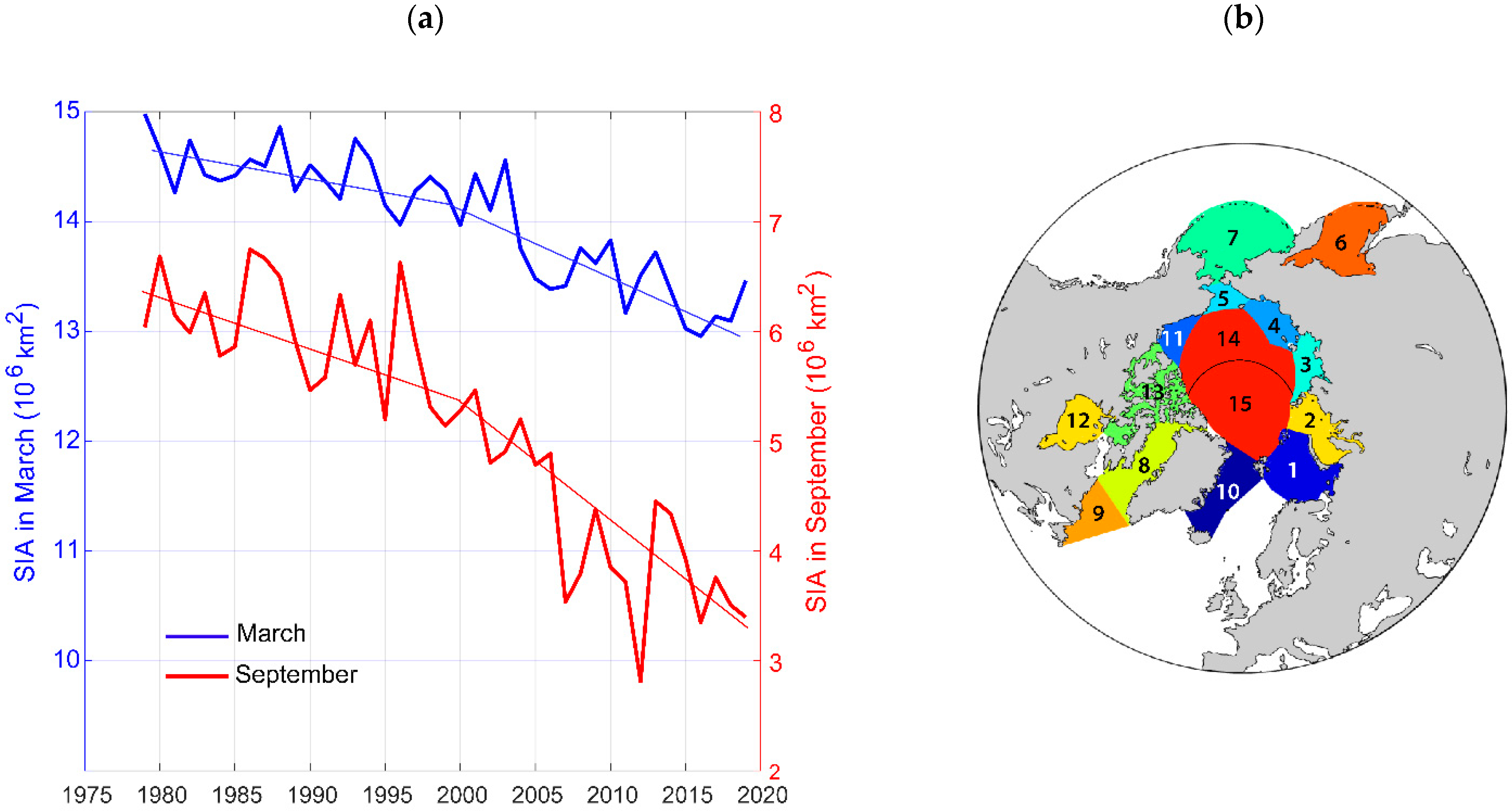

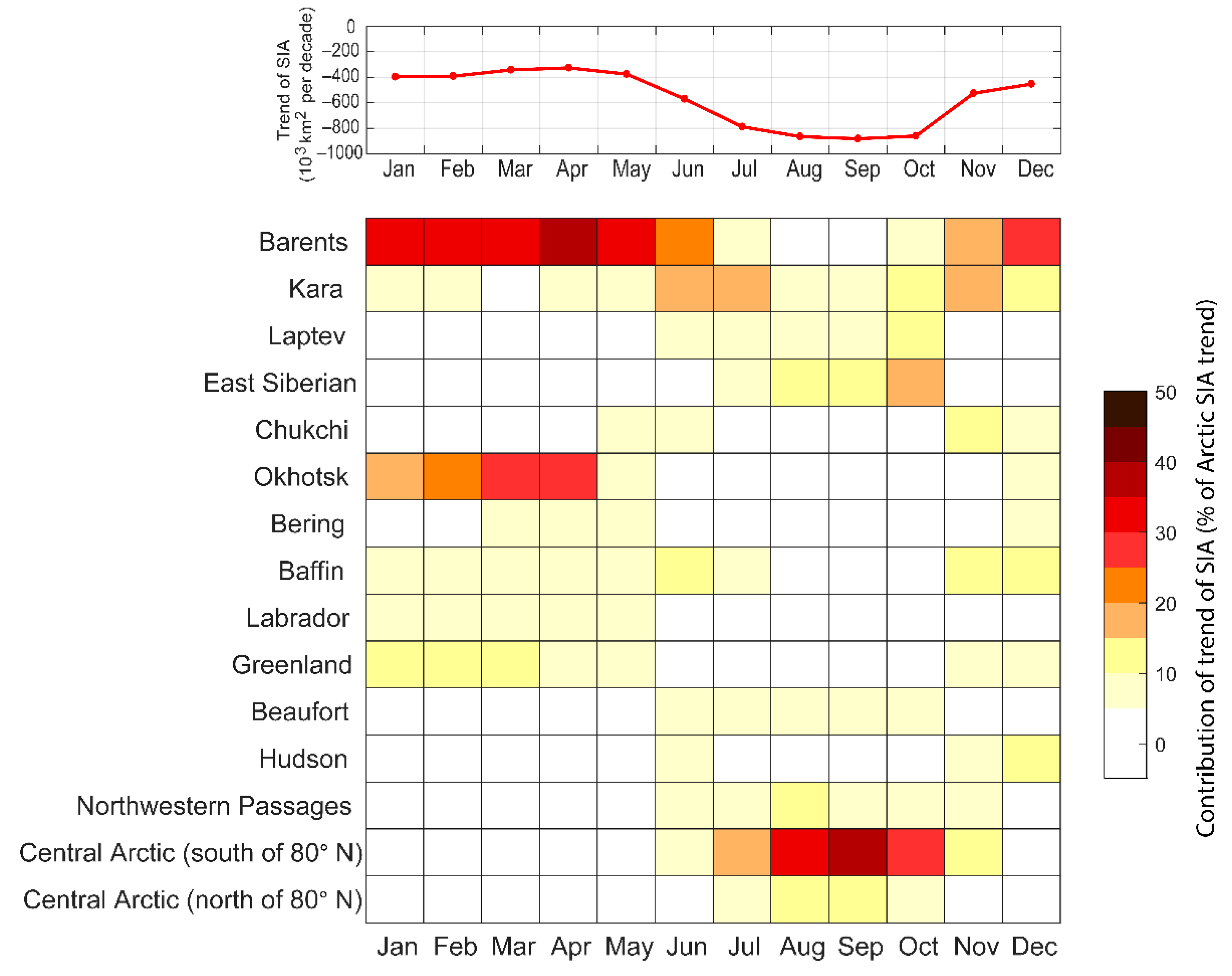
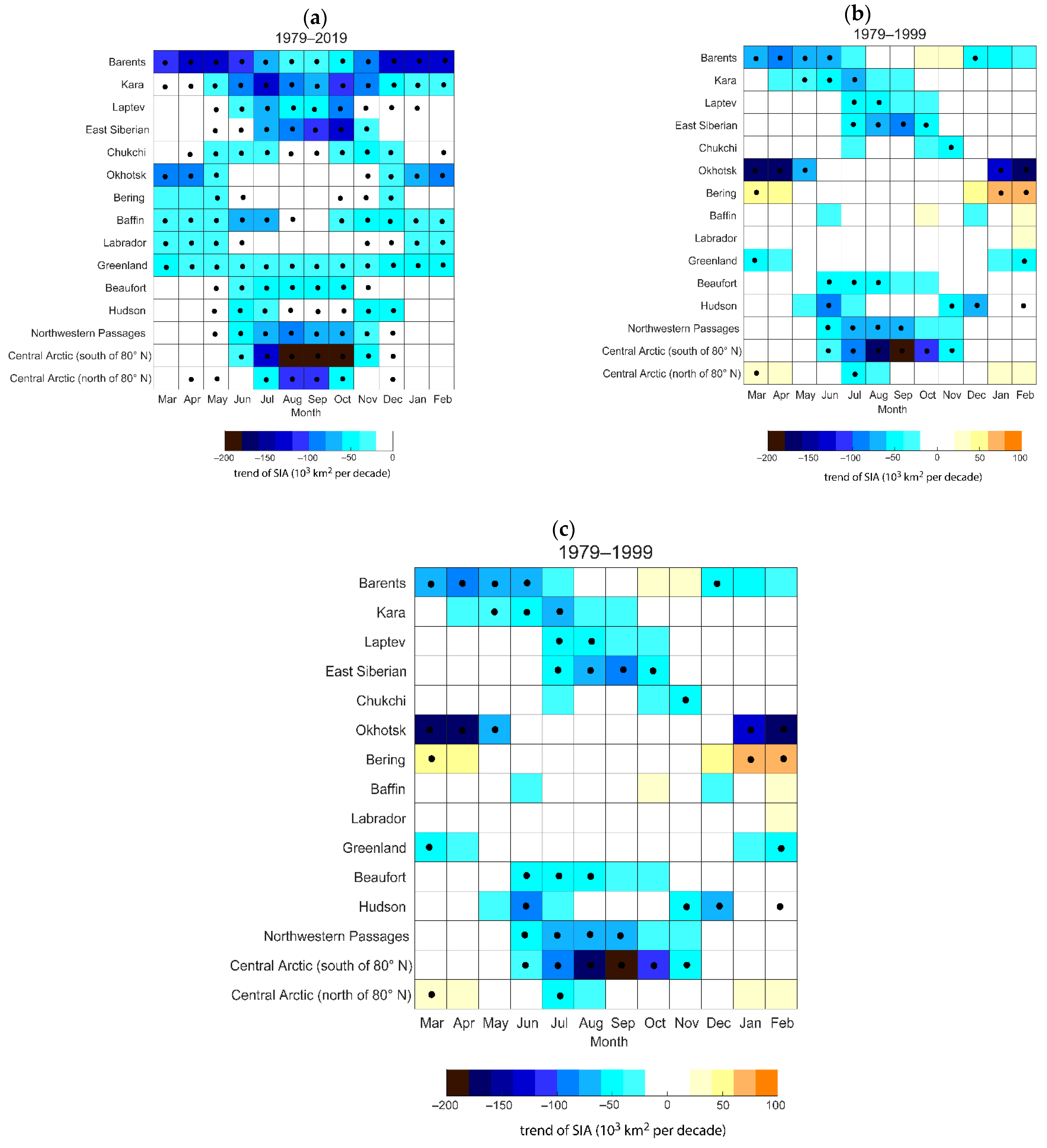
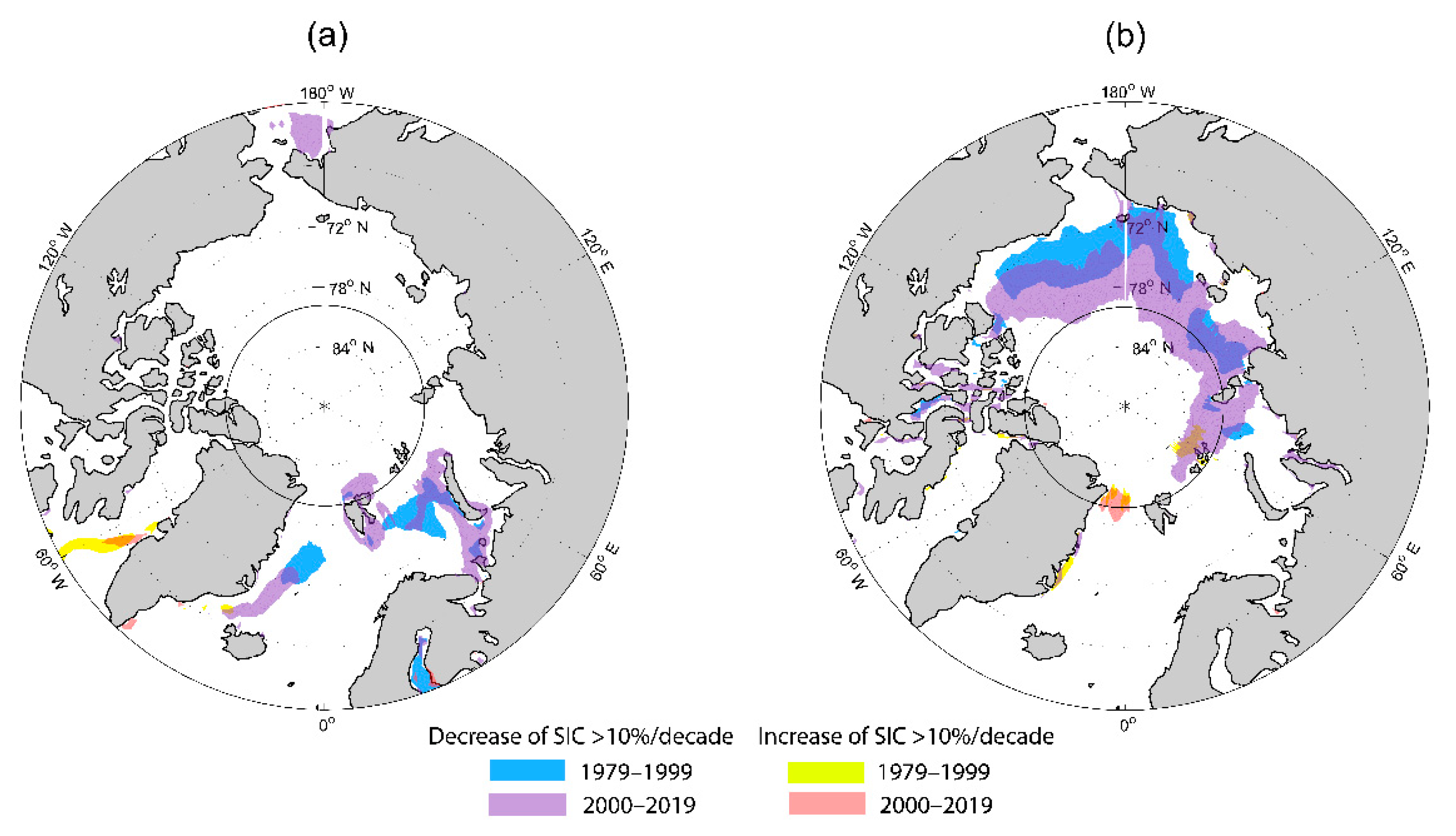
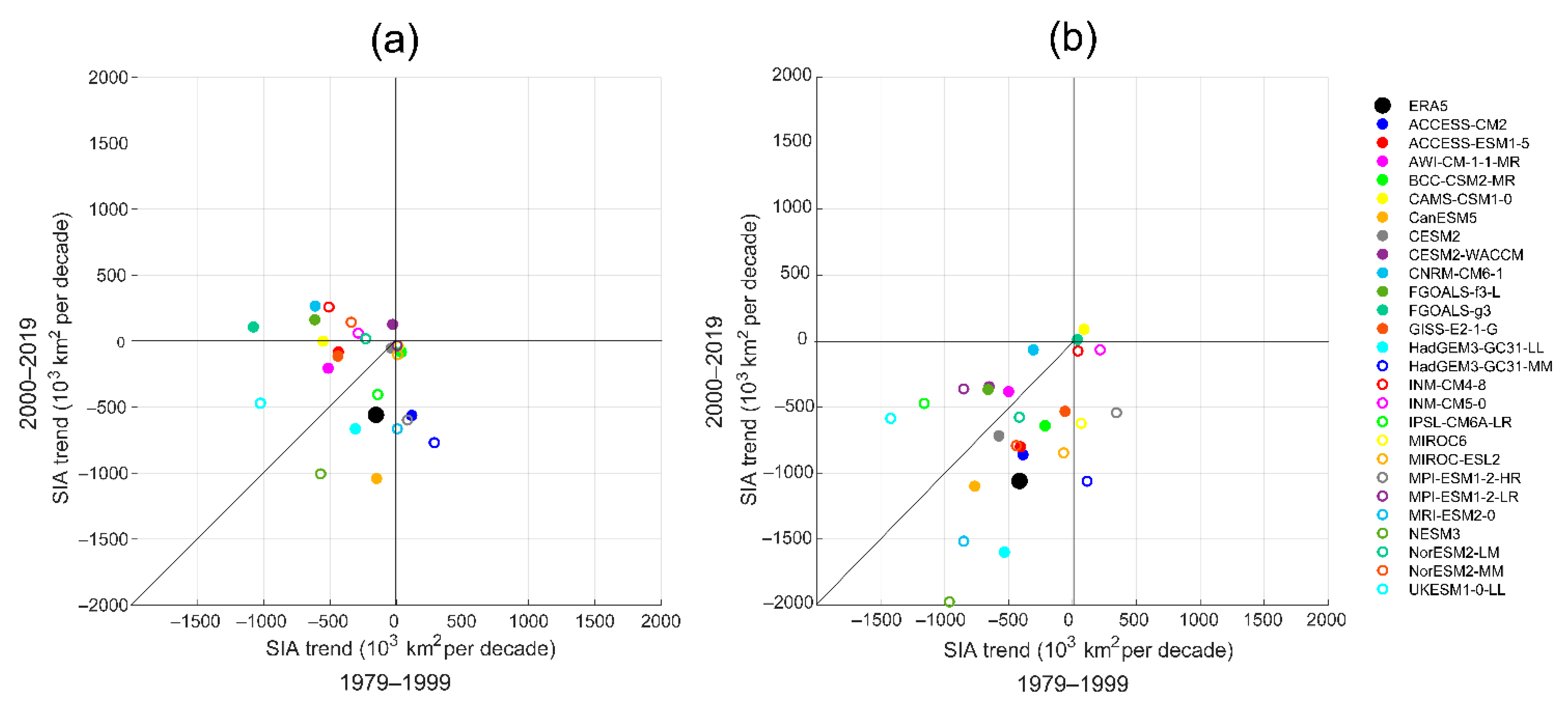
Publisher’s Note: MDPI stays neutral with regard to jurisdictional claims in published maps and institutional affiliations. |
© 2022 by the authors. Licensee MDPI, Basel, Switzerland. This article is an open access article distributed under the terms and conditions of the Creative Commons Attribution (CC BY) license (https://creativecommons.org/licenses/by/4.0/).
Share and Cite
Matveeva, T.A.; Semenov, V.A. Regional Features of the Arctic Sea Ice Area Changes in 2000–2019 versus 1979–1999 Periods. Atmosphere 2022, 13, 1434. https://doi.org/10.3390/atmos13091434
Matveeva TA, Semenov VA. Regional Features of the Arctic Sea Ice Area Changes in 2000–2019 versus 1979–1999 Periods. Atmosphere. 2022; 13(9):1434. https://doi.org/10.3390/atmos13091434
Chicago/Turabian StyleMatveeva, Tatiana A., and Vladimir A. Semenov. 2022. "Regional Features of the Arctic Sea Ice Area Changes in 2000–2019 versus 1979–1999 Periods" Atmosphere 13, no. 9: 1434. https://doi.org/10.3390/atmos13091434
APA StyleMatveeva, T. A., & Semenov, V. A. (2022). Regional Features of the Arctic Sea Ice Area Changes in 2000–2019 versus 1979–1999 Periods. Atmosphere, 13(9), 1434. https://doi.org/10.3390/atmos13091434






